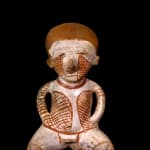Chinesco Style (Type C) Nayarit Terracotta Sculpture of a Seated Woman, 100 BCE - 250 CE
Terracotta
5.75
PF.2436 (LSO)
This attractive sculpture of a seated woman comes from the Mexican state of Nayarit, located on the Pacific coast. Archaeologically and historically it shares a great deal with Jalisco and...
This attractive sculpture of a seated woman comes from the Mexican state of Nayarit, located on the Pacific coast. Archaeologically and historically it shares a great deal with Jalisco and Colima, not least its production of extremely high-quality ceramic vessels and figures. Comparatively little is known of the people who produced them; like their neighbours mentioned above, they lived in small agricultural communities, with strong reliance upon familial/
tribal networks, judging from the multiple family burials (shaft tombs) that have been discovered. These tombs, which are up to twenty metres deep, have supplied almost all the ceramics and social information we currently have about these populations. Known trends in sculptural theme include representations of ball-players, ancestor pairs, warriors, women (maternity figures) and zoomorphic pieces, although these are much more common in states such as Colima. Styles vary through time, although precise relationships are uncertain. The most realistic is the Ixtlan del Rio style of highly-adorned and accurately-modelled human figures with stylised faces. Nayarit tableaux are also known, constituting groups of abstract and figurative designs apparently intended to be devotional pieces. The best-known style is the Chinesco or Chinesca style, named for their supposedly Chinese appearance – impassive faces, linear eyes – of which there are five claimed types (the validity of the divisions is open to question due to their considerable overlap). Type A is unusual in its realism, while types B-E are more or less abstract, with major interpretation of proportions, limbs and faces.
This piece is a classical example of the latter style, and shares various characteristics with type “C”, although, as stated above, this is open to interpretation. The piece depicts a kneeling woman with legs splayed and her hands on her hips. The head is disproportionately large, with a flat face, a broad nose, slit eyes and mouth, and protuberant, small ears topped off with a red-painted plain headdress. The lower half of the body is also oversized, with large, modelled hips contrasting with nugatory legs. Her arms are likewise modelled in a very expressive manner, without joint detail, and merging seamlessly with the hips without details such as hands or fingers. The ground of the piece is white, highlighted with an orange-red hatched design representing a tunic-like item of clothing and a belt. There are also large hatched triangles on each cheek.
The role of the piece is uncertain, but the exaggerated feminine characteristics suggest that fertility might have been the intended sentiment. The sophistication of Nayarit sculptors and their ability to move away from standard figurative concepts is well represented here, and it also constitutes a striking and attractive piece of sculpture that would take a proud position in any collection of ancient Central American art.
tribal networks, judging from the multiple family burials (shaft tombs) that have been discovered. These tombs, which are up to twenty metres deep, have supplied almost all the ceramics and social information we currently have about these populations. Known trends in sculptural theme include representations of ball-players, ancestor pairs, warriors, women (maternity figures) and zoomorphic pieces, although these are much more common in states such as Colima. Styles vary through time, although precise relationships are uncertain. The most realistic is the Ixtlan del Rio style of highly-adorned and accurately-modelled human figures with stylised faces. Nayarit tableaux are also known, constituting groups of abstract and figurative designs apparently intended to be devotional pieces. The best-known style is the Chinesco or Chinesca style, named for their supposedly Chinese appearance – impassive faces, linear eyes – of which there are five claimed types (the validity of the divisions is open to question due to their considerable overlap). Type A is unusual in its realism, while types B-E are more or less abstract, with major interpretation of proportions, limbs and faces.
This piece is a classical example of the latter style, and shares various characteristics with type “C”, although, as stated above, this is open to interpretation. The piece depicts a kneeling woman with legs splayed and her hands on her hips. The head is disproportionately large, with a flat face, a broad nose, slit eyes and mouth, and protuberant, small ears topped off with a red-painted plain headdress. The lower half of the body is also oversized, with large, modelled hips contrasting with nugatory legs. Her arms are likewise modelled in a very expressive manner, without joint detail, and merging seamlessly with the hips without details such as hands or fingers. The ground of the piece is white, highlighted with an orange-red hatched design representing a tunic-like item of clothing and a belt. There are also large hatched triangles on each cheek.
The role of the piece is uncertain, but the exaggerated feminine characteristics suggest that fertility might have been the intended sentiment. The sophistication of Nayarit sculptors and their ability to move away from standard figurative concepts is well represented here, and it also constitutes a striking and attractive piece of sculpture that would take a proud position in any collection of ancient Central American art.



